
Watercolor pencils are a unique medium for creating art. They combine drawing with painting in a manner that no other medium can replicate.
Watercolor pencils are a medium that give the artist the best of both worlds of painting and drawing. They are similar to colored pencils but behave differently when water is added. This is because colored pencil pigment is held by a waxy or oil-based binder, while watercolor pencils have a water-soluble binder.
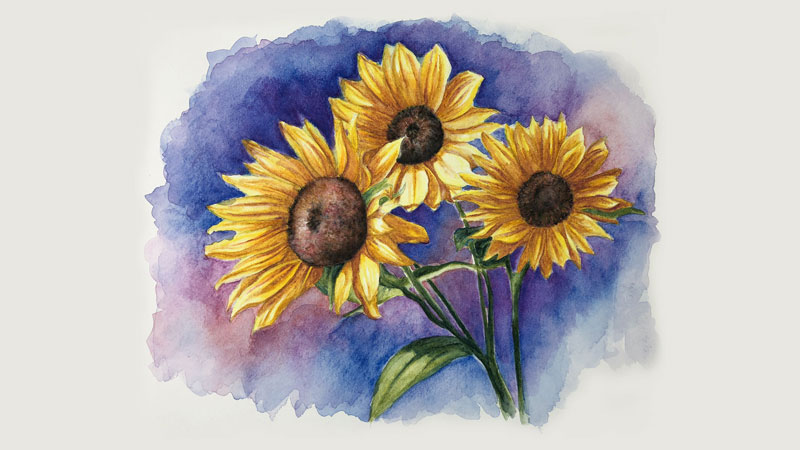
Because the medium is encased inside of a pencil that can be sharpened, the artist can create detailed and delicate marks that may be difficult to achieve with a brush.
The manner in which watercolor pencils are used is ultimately up to the artist. But, as with any medium, there are some things that may be helpful to keep in mind. Here are a few suggestions for drawing with watercolor pencils...
Watercolor pencils are designed to be used with water, which can be applied with a soft brush after making marks with the pencil. This process is called activation. Once the material has been "activated", it behaves like watercolor.
Typically, water is applied with a brush, but sponges and other tools can be used as well. Nylon brushes work well for this, but natural hair brushes work too. Bristle brushes are typically used for heavier bodied media like oils or acrylics, so it may be best not to use them with watercolor.
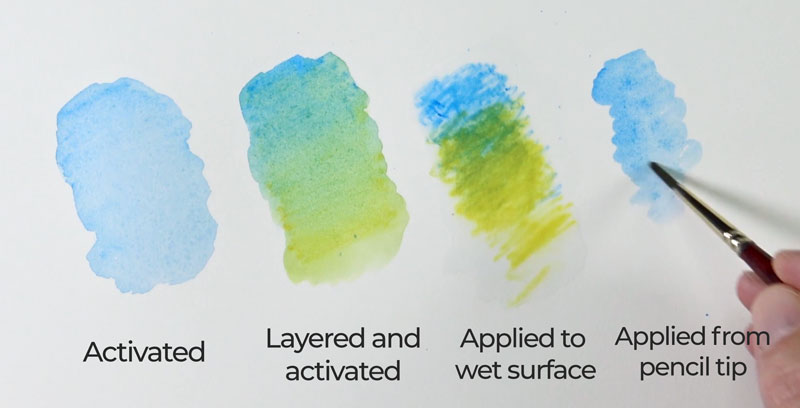
Watercolor pencils can be mixed, mostly through layering. To mix colors, apply one color and then layer an application of a second color over the top or right next to the first color. Then, activate the area with water. The colors will mix together.
To produce additional depth in the color and additional mixing, allow the first layer to dry completely. Then you can repeat the process with another round of mixed colors over the top of the dried area.
I would suggest layering only a few colors at a time to prevent muddied colors. I would not suggest mixing more than 4 colors at once. You can also have a test sheet of paper on hand to test your mixtures prior to applying them to your finished work.
As is the case with any art medium that you use, experimentation is important. Try applying the pencil directly to an area that is saturated with water to create interesting effects and bold applications of color.
You aren't limited to applying the pencil to the surface. You can also take the pigment directly from the tip of the pencil with a brush loaded with water. You can then apply the color directly to the surface with a brush, just like with traditional watercolors. This technique often results in a lighter and less intense application of color.
Watercolor pencils should be applied to watercolor paper or a heavy board such as illustration board. As water is applied, thinner papers will buckle or even tear.
Cold press watercolor papers typically have a heavier texture or "tooth". While some artists will prefer the texture, others may find that smoother surfaces are better suited for their needs. Below is an image of a watercolor pencil drawing on cold press paper from The Watercolor Workshop...
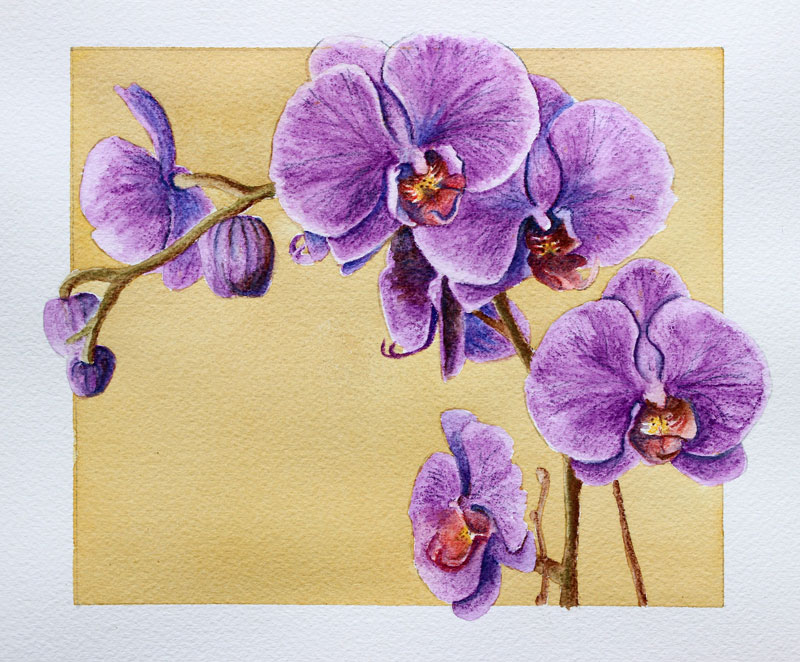
A solution for these artists would be illustration board or hot press watercolor paper (used in the demonstration video above and the step by step below). Illustration board will provide the rigid support that is required while providing a smoother surface for more precise detailing.
For this demonstration, we'll work from a photo reference. We'll make a special effort to alter the colors to create a work of art that isn't a direct copy of the photo. The reference we'll use is from pixabay.com. I've altered the original image a bit to make the composition a little stronger...
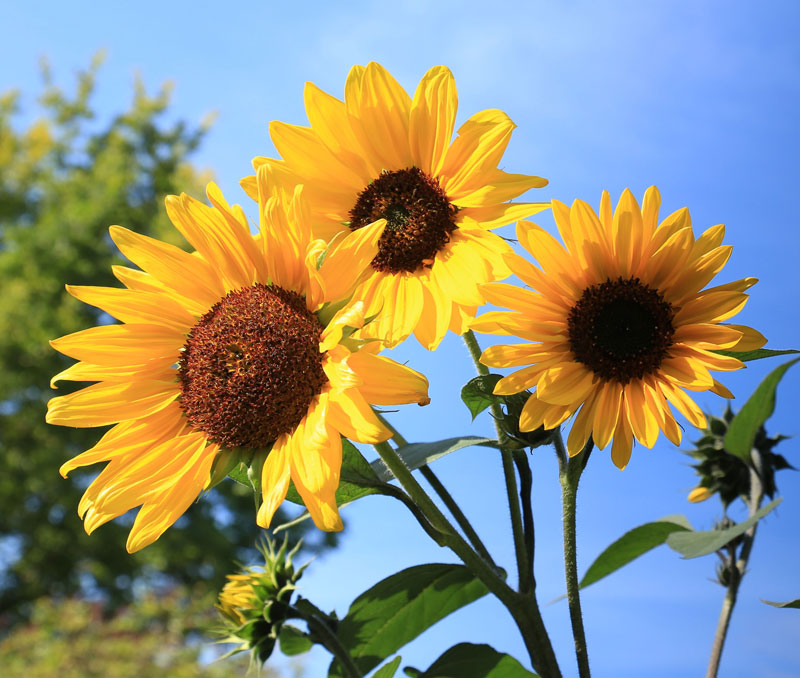
Derwent watercolor pencils are used for this lesson, working from a basic set of 24. We'll work on 140 lb. hot press watercolor paper, which is quite a bit smoother than cold press paper.
We'll begin by creating a light pencil sketch on hot press watercolor paper with a graphite pencil. Only the contour lines or outlines are drawn with no shading.
We'll address the background first and then work our way to the sunflowers. Since the sunflower petals are yellow, we'll create a contrasting background made up of mostly purples. Purple is the complement of yellow so this color should provide high contrast. To add a bit of variety and interest, we'll include some blues and reds as well.
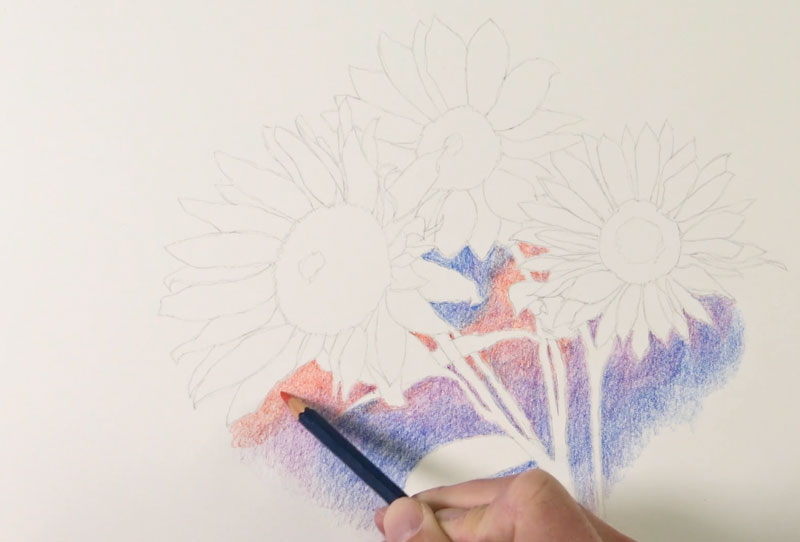
Next we can activate the colors in the background using a large nylon brush loaded with water. As the colors are activated, they mix and begin to take on the characteristics of traditional watercolor.
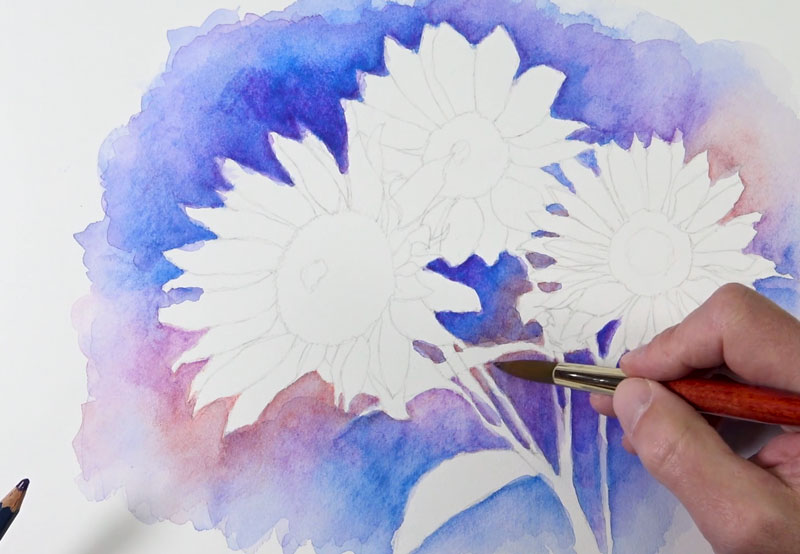
After activating the background and waiting for it to dry completely, we can go back with another application of watercolor pencils. This additional application is applied in areas where we want the color to be more intense. In this case, additional applications of blue and purple are added around the edges of the flower petals. Again, these applications are activated with water.
Once the background is complete, we'll move on to the center portions of the sunflowers. Although these areas are fairly dark, we'll be sure to add some color here. We'll patiently layer a series of colors including Crimson Lake (red), Brown Ochre (yellowish-brown), and Copper Beech (brown). This first layer of colors are then activated with a bit of water.
Once this first layer has dried, we'll apply an additional round of these colors and add Prussian Blue (dark blue) and Ivory Black.
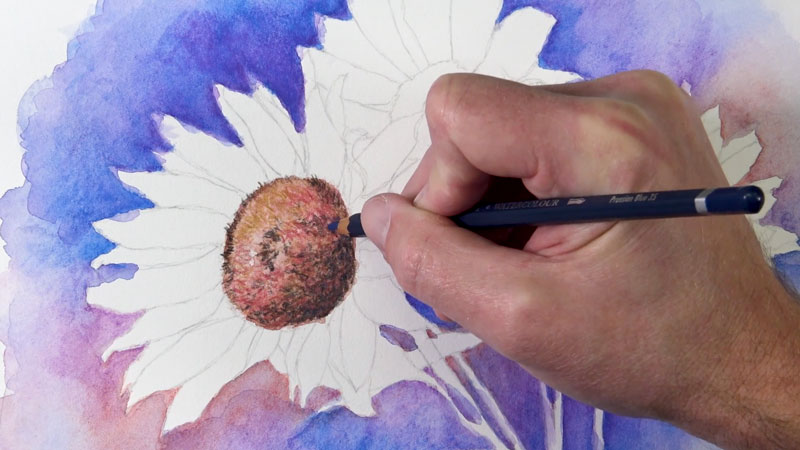
We can continue this same pattern of colors for the other two sunflowers, activating and layering as we go.
Once all of the center portions of the flowers have been addressed, then it's time to develop the petals. Three yellows are used for the base applications: Lemon Yellow, Cadmium Yellow, and Golden Brown. Lemon Yellow is applied in locations where the value is at its lightest, while Cadmium Yellow serves as the midtone. Golden Brown is used for the darker locations.
These colors are then activated with water using a small round brush for added control. While these colors provide a nice base color, we still need to push the colors further and also increase the contrast.
To add a bit of color, Orange Chrome is applied mainly in the areas of medium value. To increase the contrast and make the shadows a bit stronger, Imperial Purple is applied. Purple may seem like a strange choice, but since it is the complement of yellow, it will create a more natural looking shadow. After this second round of colors have been applied, they are activated with water.
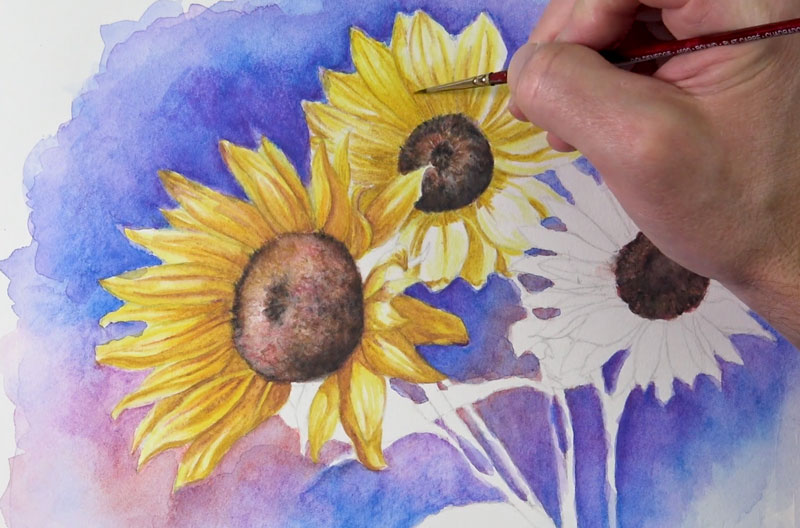
After addressing each of the petals on all of the sunflowers, we'll next develop the stems and the leaves. Again, we'll use a basic combination of colors to do so.
We'll begin with an application of Olive Green. This color will serve as the main color. For the areas of lighter value, we'll layer a bit of Lemon Yellow and in the shadows, a bit of Prussian Blue.
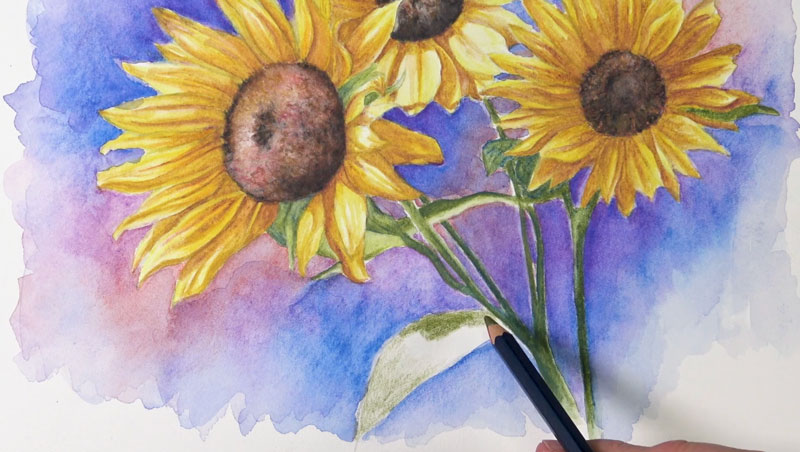
After these colors are activated, we can see that we need to darken some of the shadows in order to increase the contrast. With a light touch, a bit of Ivory Black is applied in the shadowed areas and activated. As the black is activated, it mixes with the colors underneath, creating a more natural appearance.
Now our drawing (or painting) of sunflowers with watercolor pencils is now complete.

Watercolor pencils can used for any subject that you wish. Since they behave like watercolor after they are activated, any subject that you may choose for a watercolor painting is also suitable for watercolor pencils. Below, you'll see a watercolor pencil image of a landscape.
The following video features excerpts from 2 one hour recorded live lessons on drawing/painting with watercolor pencils. (Members have access to the entire unedited lessons which can be accessed here.)
As you can see, the completed image is very similar to that of a watercolor painting...
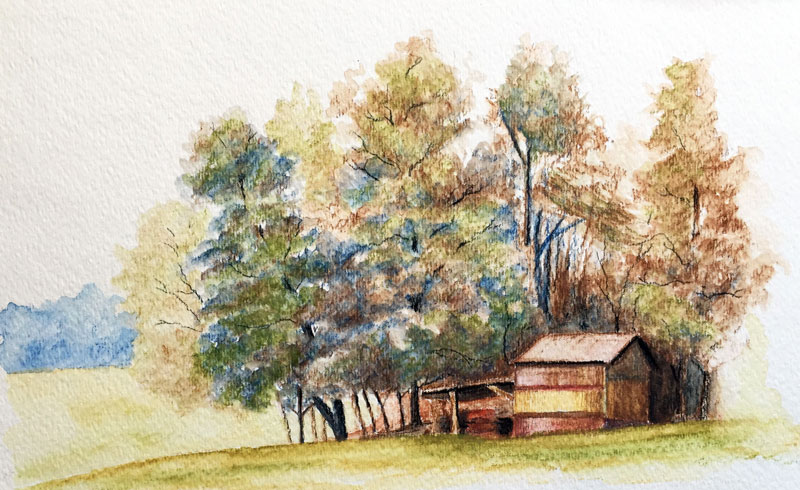
Here's another example of an image created with watercolor pencils. This one is from The Colored Pencil Course...
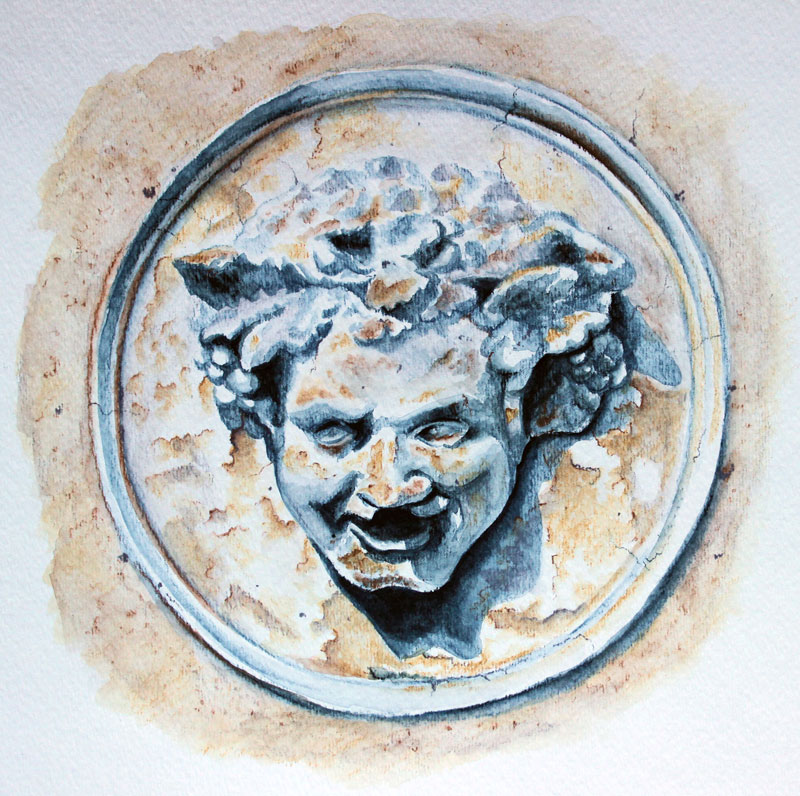
In this work, the pencils are used slightly differently. Not all of the applications are activated fully with water. This creates an image that is unique to that of watercolor pencils.
As is the case with any art medium that you use, the quality of the pencil makes a difference. That being said, you can still get fairly good results with lower quality and less expensive watercolor pencils. The same techniques we've discussed here apply, but you're likely to notice that the pigmentation of cheaper pencils isn't very strong.
The following video is one of the very first I created. It uses lower quality watercolor pencils but also demonstrates how you can get decent results if you know how to use the medium...
Just like we did with the first demonstration, we first apply the watercolor pencils as if we are drawing the image with traditional colored pencils. Instead of applying heavy pressure however, we'll apply light applications first and then layer after activating.
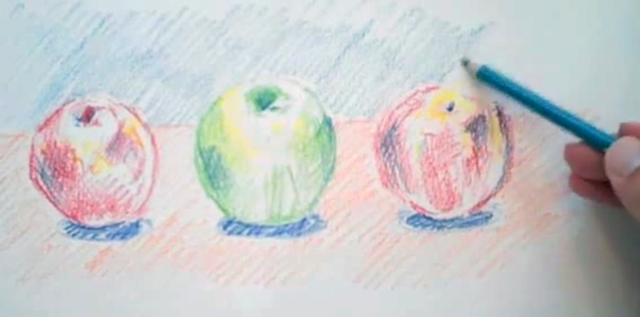
Activating Watercolor Pencils with Water
Here again, we'll activate these applications with water applied with a brush. It is advised to slowly build up applications and activate them in layers so that the value and intensity of the color can be fully controlled.
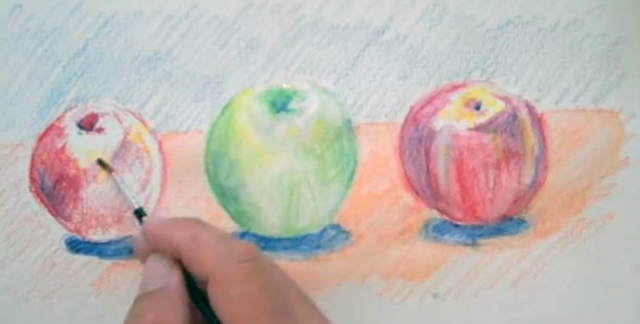
Layering Applications of Watercolor Pencils
As layers dry, additional applications of watercolor pencil can be drawn over layers underneath. This allows us to control the color and adjust the painting gradually.
Areas do not have to be completely dry. Pencils can be applied while areas are still wet, producing interesting effects.
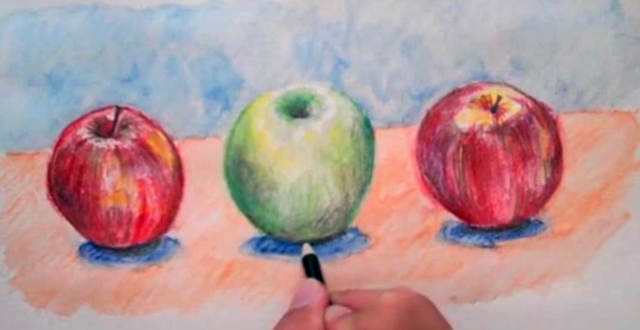
Areas can be erased or "lifted" using traditional watercolor techniques. Water can be applied to the area that is desired to be removed and a cotton swab, brush, or paper towel can be used to pull color up. Although it may be difficult to remove the color completely, areas can made lighter using this technique.
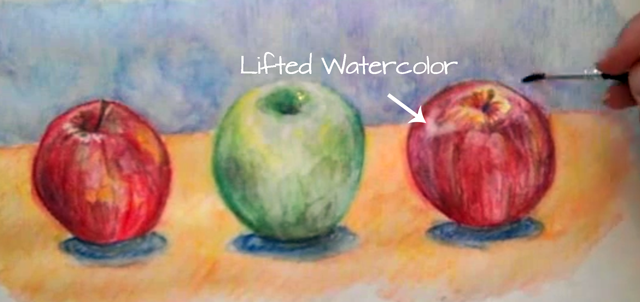
Watercolor pencils are inexpensive and portable giving them an advantage over traditional watercolors. They can be picked up at any art store. Because they can be sharpened to a fine point, it's easy to develop details that may be hard to get with traditional watercolor paints. Watercolor pencils can be used alongside traditional watercolor paints as well.
While watercolor pencils provide some advantages, there are some traditional watercolor techniques that may be difficult to duplicate.